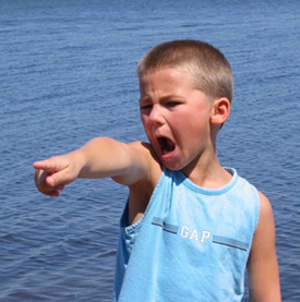Abnormal behavior in children is considered as any type of behavior that interferes with daily functioning. Abnormal behavior can be symptoms of anxiety, depression, eating disorders, extreme defiance, rage or physical aggression to self or others. Behavior is a tool of communication that children use when they don’t have the words to express themselves to others. It is important to pay attention to sudden changes in behavior that are outside the normal developmental milestones based on the age of the child.
 Perhaps the most important aspect of childhood psychopathology is that it must be viewed in a developmental context. Until relatively recently, theory and classification of child disorders were merely extensions of work with adults. The important and often profound changes that occur in physical and psychological development were often overlooked.
Perhaps the most important aspect of childhood psychopathology is that it must be viewed in a developmental context. Until relatively recently, theory and classification of child disorders were merely extensions of work with adults. The important and often profound changes that occur in physical and psychological development were often overlooked.
1. Chronological age: At the most basic level, problem definition depends on the age of the child. Behaviors that would be considered abnormal at one age level, might be perfectly appropriate at another age level.  For example, bed wetting, inability to read, fear of strangers, anxiety and distress when left alone are certainly problems if they occur in a 12-year-old, but these same behaviors are normal with a 1- or 3-year-old.
2. Cognitive-developmental level: The child and the adolescent clearly have different cognitive capabilities. Problem solving, the ability to take another person’s point of view, self-concept, morality…all these develop through time. For example, some of you are probably familiar with the work of Piaget, the Swiss psychologist who proposed a series of stages that all children go through as their cognitive abilities develop. His theory illustrates how we all move from primitive and very limited abilities in our early years, to increasingly complex and sophisticated abilities as we move through childhood. The point is this: how a particular behavior is perceived, interpreted, and labelled by adults (ie: normal vs abnormal) will depend in large part on the child’s level of cognitive development. For example: Parental interpretations of aggressive behavior vary with the age of the child. Aggressive behavior in 2- and 3-year-olds is rarely seen as a problem requiring treatment. This is because it is largely understood that at this age, the child does not “mean” to hurt another person. S/he has not reached the stage of cognitive development that permits him/her to take the perspective of another person. Thus, s/he is not able to connect his/her behavior with the inflicting of pain. Aggression at this age is frequently over possession of a toy, reflecting the ego-centric (“self-oriented”) nature of their cognitive processes. The egocentrism/lack of perspective taking which is normal at this age leads adults to see such behaviors as less problematic at this age level. Indeed, many “problems”, especially those of the first few years of life, are often transitory: as the child matures, the problems will fade away.
 At a later age, say 8 years-old, similar behavior would begin to become a concern. At this stage of development, although still largely egocentric, the child’s cognitive abilities are increasing: s/he is able to use and understand language to a much greater degree, symbolic thought increases, s/he is able to follow rules to a certain extent…all of which suggests the child’s ability to “think about what they are doing”. Parents will no longer overlook aggressive behavior; they will try to teach their child “proper” behavior. Excessive aggressive behavior may lead to a referral for treatment of some sort.
At a later age, say 8 years-old, similar behavior would begin to become a concern. At this stage of development, although still largely egocentric, the child’s cognitive abilities are increasing: s/he is able to use and understand language to a much greater degree, symbolic thought increases, s/he is able to follow rules to a certain extent…all of which suggests the child’s ability to “think about what they are doing”. Parents will no longer overlook aggressive behavior; they will try to teach their child “proper” behavior. Excessive aggressive behavior may lead to a referral for treatment of some sort.
At an even older age level, say 13 years, these same aggressive behaviors would be considerable cause for concern. In addition to treatment, the juvenile legal system may begin to be involved. At this age, the adolescent is at a developmental level where it is expected that s/he can take another person’s point of view, that s/he can fully think about his/her own actions and their outcomes.
 3. Prognostic implications: Factors such as age and cognitive level determine, in part, whether or not a particular behavior problem spells trouble for the future. Although the child may be having difficulties presently, does that mean s/he will continue to have problems? Diagnosing a child implies stability, which, as we have seen, may not be warranted. Many of the problems seen in childhood have “little if any predictive value for adult functioning”.  The question then is at what point does a problem behavior become a legitimate target for inclusion in a diagnostic system.
3. Prognostic implications: Factors such as age and cognitive level determine, in part, whether or not a particular behavior problem spells trouble for the future. Although the child may be having difficulties presently, does that mean s/he will continue to have problems? Diagnosing a child implies stability, which, as we have seen, may not be warranted. Many of the problems seen in childhood have “little if any predictive value for adult functioning”.  The question then is at what point does a problem behavior become a legitimate target for inclusion in a diagnostic system.
B. Environmental factors: Children are dependent on others. This fact has important implications in our analysis of psychopathology.
1. Stability: Children’s behavior is much less stable than adults’ behavior, because it is more responsive to environmental changes and manipulations. A child’s behavior can vary dramatically from one situation to another. What the adults are doing in the child’s environment, and simply which adults are present, can have a profound impact on the child’s behavior. For example: the problem may occur only in the presence of certain people (an overly permissive parent). Therefore, it may be as important to assess the child’s environment as it is to assess the child’s “problem”.
